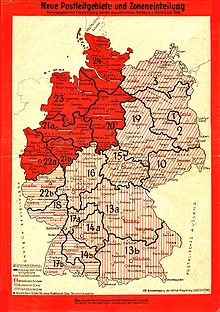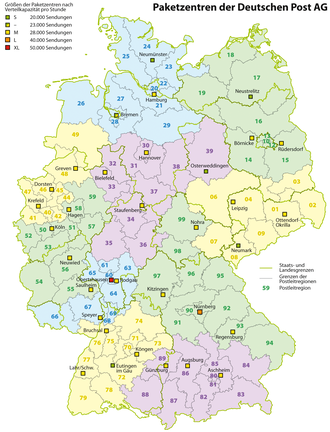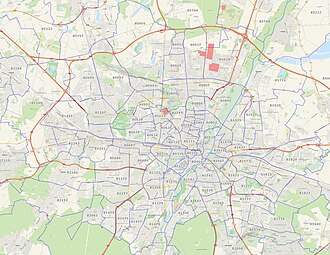List of postal code regions in Germany
The list of postal routing regions in Germany gives an overview of the postal routing regions used since 1941. The historical and systematic structure of the postal routing systems in Germany can be found in the article Postcode (Germany) .
The Deutsche Reichspost introduced a two-digit system from 1941. This was continued by the Allied occupying powers and only replaced in the 1960s by two four-digit postcode systems of the Deutsche Bundespost and the Deutsche Post of the GDR . On July 1, 1993, the current five-digit postcode system was introduced.
The first digit of the five-digit postcode designates the zone (and thus the commercial airport from which the mail is delivered), the second digit the region (the first two digits are therefore often called the postal routing region or routing region; usually continuous counterclockwise from the central location - starting in South). In the postcode regions, the postcode areas are combined that have the same two initial digits. Post usually operates one of the 82 mail centers in the routing regions, 10 of these centers are responsible for 2 routing regions each.
list
Two-digit system from 1941 to 1945
While the postal routing areas from 1941 initially only applied to parcels and parcels, in 1944 they became binding for the normal mailing of letters and postcards. The following table therefore contains the status from 1944. When assigning the postcode, one mostly orientated oneself on the existing Gau boundaries of the NSDAP , also in the occupied areas. The areas and cities mentioned in the table below are taken from the field post folded letter shown opposite.
| Number of the routing area | Postal code area | mainly comprised the NSDAP district |
|---|---|---|
| 1 | Berlin inner city and Berlin outer city | Gau Berlin |
| 2 | Brandenburg Province | Gau Mark Brandenburg and Gau Pommern , the urban district of Schneidemühl and the districts of Arnswalde , Friedeberg (Neumark) and Netzekreis |
| 3 | Mecklenburg | Gau Mecklenburg |
| 4th | Pomerania | Gau Pomerania (without the exceptions belonging to 2) |
| 5a | West Prussia | Gau Danzig-West Prussia |
| 5b | East Prussia | Gau East Prussia |
| 5c | Ostland | Reichskommissariat Ostland |
| 6th | Wartheland | Gau Wartheland |
| 7a | General Government | General Government |
| 7b | Ukraine | Reichskommissariat Ukraine |
| 8th | Lower Silesia | Gau Lower Silesia |
| 9a | Upper Silesia | Gau Upper Silesia |
| 9b | East Sudetenland | Gau Sudetenland East |
| 10 | Saxony | Gau Sachsen , Gau Halle-Merseburg and from Gau Thuringia the district of Altenburg |
| 11a | West Sudetenland | Gau Sudetenland West |
| 11b | Protectorate of Bohemia and Moravia | Protectorate of Bohemia and Moravia |
| 12a | Alpine and Danube Reichsgau East | Gau Wien , Gau Niederdonau , Gau Steiermark |
| 12b | Alpine and Danube Reichsgau West | Gau Carinthia , Gau Oberdonau , Gau Salzburg , Gau Tirol-Vorarlberg |
| 13a | Northern Bavaria | Gau Bayreuth , Gau Franken , Gau Mainfranken |
| 13b | Southern Bavaria | Gau München-Oberbayern , Gau Schwaben and from Gau Bayreuth the district of Lower Bavaria without the urban district of Straubing and the districts of Kötzting, Bogen, Straubing and Kelheim |
| 14th | Württemberg | Gau Württemberg - Hohenzollern |
| 15th | Thuringia | Gau Thuringia |
| 16 | Hesse | Gau Hessen-Nassau , Gau Kurhessen |
| 17a | to bathe | Gau Baden |
| 17b | Alsace | Part of Gau Baden: Alsace |
| 18th | Westmark | Gau Westmark |
| 19th | Magdeburg area, Anhalt | Gau Magdeburg-Anhalt |
| 20th | Province of Hanover, Braunschweig | Gau East Hanover , Gau South Hanover-Braunschweig |
| 21st | Westphalia | Gau Westphalia-North , Gau Westphalia-South |
| 22nd | Rhineland, Luxembourg | Gau Düsseldorf , Gau Essen , Gau Cologne-Aachen , Gau Moselland |
| 23 | Bremen, Oldenburg area | Gau Weser-Ems and from Gau Ost-Hannover the districts Bremervörde , Wesermünde , Verden (Aller) , Rotenburg (Hanover) and Osterholz-Scharmbeck as well as from Gau Süd-Hannover-Braunschweig the districts Counties Hoya and Diepholz . |
| 24 | Hamburg, Schleswig-Holstein area | Gau Hamburg , Gau Schleswig-Holstein and from Gau East Hanover the districts of Land Hadeln , Stade , Lüneburg , Harburg and the city of Cuxhaven |
Continued use of the two-digit system from 1945 to 1961/1965
Allied occupation zones

After the Second World War, the Allied occupying powers continued to use the existing postal code areas. However, slight adjustments had to be made to the respective occupation zones . The postal code areas 4 to 9 as well as 11 and 12 were omitted. In the routing areas 14b, 17b and 18 there was no Reichspost or Oberpostdirektion, so the locations are only examples for the larger cities of the respective region in brackets and are also in italics .
| Number of the routing area | Postal code area | Seat of a Reichspost or Oberpostdirektion | Occupation zone |
|---|---|---|---|
| 1 | Berlin | Berlin | Four power status |
| 2 | Brandenburg | Potsdam | Soviet occupation zone |
| 3 | Mecklenburg-Western Pomerania | Schwerin | Soviet occupation zone |
| 10 | Saxony | Dresden and Leipzig | Soviet occupation zone |
| 13a | Northern Bavaria (Franconia, Upper Palatinate, Straubing) | Nuremberg, Regensburg | American zone of occupation |
| 13b | Southern Bavaria (Upper Bavaria, Lower Bavaria without Straubing, Swabia) | Munich | American zone of occupation |
| 14a | North Württemberg | Stuttgart | American zone of occupation |
| 14b | South Württemberg and Hohenzollern | none (Tübingen, Freudenstadt, Rottweil, Sigmaringen, Friedrichshafen) | French zone of occupation |
| 15th | Thuringia | Erfurt | Soviet occupation zone |
| 16 | Großhessen | Frankfurt am Main | American zone of occupation |
| 17a | North Baden | Karlsruhe | American zone of occupation |
| 17b | South Baden | none (Baden-Baden, Offenburg, Lahr, Freiburg im Breisgau, Lörrach) | French zone of occupation |
| 18th | Rheinhessen-Palatinate, Saarland | none (Mainz, Worms, Ludwigshafen am Rhein, Neustadt an der Haardt / Weinstrasse, Neunkirchen, Saarbrücken) | French zone of occupation |
| 19th | Saxony-Anhalt | Halle (Saale) | Soviet occupation zone |
| 20th | Hanover | Braunschweig and Hanover | British zone of occupation |
| 21a | North Westphalia | Muenster | British zone of occupation |
| 21b | South Westphalia | Dortmund | British zone of occupation |
| 22a | North Rhine | Cologne | British zone of occupation |
| 22b | Hunsrück, Eifel, Taunus, Westerwald | Koblenz | French zone of occupation |
| 23 | Oldenburg | Bremen | British zone of occupation |
| 24 | Schleswig-Holstein | Hamburg and Kiel | British zone of occupation |
Changes after the establishment of the two German states in 1949
After the two German states were founded in 1949, the two-digit postal code areas continued to be used with slight changes. Only the changes are briefly listed below.
- 3 has been split into 3a and 3b.
- 10 has been split into 10a and 10b.
- 15 has been split into 15a and 15b.
- 18 was completely replaced by the 22b.
- 19 has been split into 19a and 19b.
- 20 has been split into 20a and 20b.
- 22a has been split into 22a and 22c.
- 24 has been split into 24a and 24b.
These post code areas were valid up to the two four-digit systems that were introduced in the 1960s.
Four-digit systems West and East from 1961/1965 to 1993
The following table shows a comparison of the two four-digit postcode systems of the Deutsche Bundespost and the Deutsche Post of the GDR, which were introduced in the first half of the 1960s. From the German reunification in 1990 to the introduction of a uniform postal code system in 1993, the former areas of the two postal administrations were referred to as traffic area west and traffic area east. The table contains the places with the corresponding postcodes in the two areas for each hundred number. Until the introduction of electronic data processing in the 1970s, the zeros were not written at the end of each number, for example Kiel or Stralsund had the postcode 23 instead of 2300 later.
Notes on the table above:
- - Post control area was not allocated or left blank
- ↑ a b c d e f The postcodes that began with these digits were reserved for the GDR when they were introduced in 1961, as were the numbers 9xxx. The 0xxx was not intended.
- ↑ a b The postcode areas 2700 and 5700 did not exist, but there were postcodes in the two routing areas that began with them. 2700 to 2719 were not awarded. Only the numbers from 2720 for Rotenburg (Wümme) , 2730 Zeven and 2740 Bremervörde were assigned, but not when the postcodes were introduced. In region 57 (northeastern Sauerland ), with the introduction of the postcodes, the numbers 575x Menden , 576x Arnsberg , 577x Meschede , 578x Bestwig and 579x Brilon were assigned.
- ↑ a b c d e f g h The double-zero areas missing in the table (3200, 3800, 3900, 5200, 6700, 7600, 8200 and 9600) were not assigned, but there were some control post offices in these areas (similar as in the West German postcode area 5700).
- Traffic area west:
- Various changes resulted from the new municipal regulations, but also for other reasons. So changed z. B. 314 Lüneburg (in area 31 Celle) to 2120 Lüneburg (in area 21 Hamburg 90) and 515 Bergheim (in area 51 Aachen) to 5010 Bergheim (in area 50 Cologne).
- In addition to Ludwigshafen am Rhein, the postal code 6700 was also used by the Bundeswehr field post , without there being any connection to Ludwigshafen. The field post control center was in 6100 Darmstadt at this time .
In the following cities in the Federal Republic an abbreviation for the name of the city was allowed. These abbreviations listed here were only permitted if a district name (the directory incorrectly states the suburb name) was added. These code letters are identical to those of the vehicle registration numbers of the cities mentioned.
| city | Abbr. | Postcode | Example: Abbreviation district |
|---|---|---|---|
| Aachen | AC | 51 | AC image |
| Berlin | B. | 1 | B-Charlottenburg 1 |
| Bochum | BO | 463 | BO Dahlhausen |
| Bremen | HB | 28 | HB-Arsten |
| Darmstadt | THERE | 61 | DA-Arheilgen |
| Dortmund | DO | 46 | DO Wellinghofen |
| Duisburg | YOU | 41 | DU-Beeck |
| Dusseldorf | D. | 4th | D-Benrath |
| eat | E. | 43 | E-Bergeborbeck |
| Esslingen (Neckar) | IT | 73 | ES-Liebersbronn |
| Frankfurt (Main) | F. | 6th | F-Eschersheim |
| Freiburg (Breisgau) | FR | 78 | FR-Betzenhausen |
| Hagen | HA | 58 | HA Bathey |
| Hamburg | HH | 2 | HH-Altona |
| Hanover | H | 3 | H-Buchholz |
| Heidelberg | HD | 69 | HD Kirchheim |
| Karlsruhe | KA | 75 | KA-Durlach |
| kassel | KS | 35 | KS-Bettenhausen |
| Cologne | K | 5 | K-Bickendorf |
| Ludwigshafen am Rhein | LU | 67 | LU-Edigheim |
| Lübeck | HL | 2401 | HL-Blankensee |
| Mannheim | MA | 68 | MA Almenhof |
| Munich | M. | 8th | M-Allach |
| Nuremberg | N | 85 | N-Eibach |
| Oberhausen (Rhineland) | IF | 42 | OB-Holten |
| regensburg | R. | 84 | R-Wedge Mountain |
| Remscheid | RS | 563 | RS haste |
| Salzgitter | SZ | 3321 | SZ-Barum |
| Solingen | SG | 565 | SG-Aufderhöhe |
| Stuttgart | S. | 7th | S-Bad Cannstatt |
| Wiesbaden | WI | 62 | WI-Bierstadt |
| Wuppertal | W. | 56 | W-Barmen |
Five-digit system since 1993




The five-digit postcodes were introduced on July 1, 1993.
See also
literature
- Postal code books
- Directory of post offices in the Reichspostgebiet with the postal code, Reichspostministerium Berlin, July 1944
- Postal code book of the Deutsche Bundespost from 1961
- List of places, districts and residential areas in the German Democratic Republic and their postal designation, edition 1965
- Forget-me-not the zip code, Deutsche Bundespost, 1977
- The postal code book, Deutsche Bundespost Postal Service, Bundesdruckerei Berlin, January 1993
- Concise dictionary of the postal system , publisher of the second completely revised edition: Federal Ministry for the Post and Telecommunications, Frankfurt am Main 1953
Web links
Individual evidence
- ^ Directory of the post offices in the Reichspostgebiet with the postcode, July 1944.
- ↑ a b Division of the postal code area 11 into 11a West Sudetenland and 11b Protectorate of Bohemia and Moravia According to: RPM dated December 13, 1943, Official Gazette of the Reich Ministry of Post No. 1 dated January 4, 1944, Official Gazette Notice 1003/1944, Corrigendum No. 1 to the letter distribution service instruction.
- ^ Manual dictionary of the postal system, 2nd edition, p. 536.
- ^ Postcode book of the Deutsche Bundespost from 1961.
- ↑ List of places, districts and residential areas in the German Democratic Republic and their postal designation, 1965 edition.
- ^ Postcodes, published and edited by the Federal Ministry for Post and Telecommunications, 1961.






